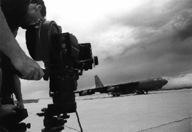Juror
Hartmut Bitomsky
 [Juror’s Statement]
[Juror’s Statement]
The documentary filmmaker doesn’t invent the world, but comes upon it. And the documentary work is saying yes to the world and in the very same instance no.
Umberto Eco once defined creativity not so much as making new things rather than taking materials that already preexist and rearranging them in a different way. The difference in “the way” makes the documentary important.
It is the ultimate form of working with ready-made materials: people and objects, facts and situations. We experience the traces and imprints of other modes of existence, but in a different context: the context of visuality and cognitive perception.
In the end documentaries are not that much apart from feature fiction—only that the extras and the props have taken over and play the main roles: yet in a story that doesn’t completely make sense, a story that doesn’t begin where the film starts and isn’t finished when the film ends.
There is more to the picture than meets the eye.
|
Hartmut Bitomsky
Born in 1942 in northern Germany. Studied at the Free University in Berlin and at the Academy for Film and Television in Berlin, and started to work as a freelance writer and producer. In 1970, directed his first film, The Division of Every Day, co-directed with Harun Farocki. His works treat a wide spectrum of subjects such as history and the present society: German Pictures (1983) and Highways of the 3rd Reich (1985), cinema: Cinema and Death (1988), Cinema and Wind and Photography (1991) and Playback (1995) and art: Imaginary Architecture (1993). Has worked as the editor of a film magazine, and has taught in various universities, colleges and art schools in both Europe and the United States. Currently he is Dean of the School of Film/Video, California Institute of the Arts. |
B-52
 GERMANY, USA / 2001 / English / Color, B&W / 35mm (1:1.85) / 112 min
GERMANY, USA / 2001 / English / Color, B&W / 35mm (1:1.85) / 112 min
Director, Script: Hartmut Bitomsky
Editor: Theo Bromin
Photography: Volker Langhoff, Hugo Kroiss
Sound: Gerhard Metz, James Benning
Producers: Hartmut Bitomsky, Albert Schwinges
Production Companies: Big Sky Film, Cofilm
Source: Hartmut Bitomsky
California Institute of the Arts
McBean Parkway 24700, Valencia, CA 91355 USA
Phone: 1-661-253-7825 Fax: 1-661-253-7824
E-mail: bitomsky@calarts.edu
The B-52 long-distance bomber aircraft was designed in 1947 and was put in service in 1952. Since then it has been one of the primary weapons of the US and western forces through the Cold War era. It is still in service after the end of the Cold War, and was used in the Gulf War and the bombarding of Serbia during the Kosovo War. It will remain in service for at least another 30 years. Through the fates of this machinery which is the result of the immense engineering capacity of American industry, the film analyzes the cultural phenomenon that the US and the world has created around war.
|
• International Competition | Angelos’ Film | A2 | Buenaventura Durruti, Anarchist | Crazy | Days in Those Mountains | La Devinière | Gaea Girls | Grandma’s Hairpin | In Vanda’s Room | The Land of the Wandering Souls | Mysterious Object at Noon | Paragraph 175 | Private Chronicles. Monologue | 6 Easy Pieces | Southern Comfort • Jurors | Hartmut Bitomsky | Bernard Eisenschitz | Ann Hui | Kuroki Kazuo | Ivars Seleckis |
